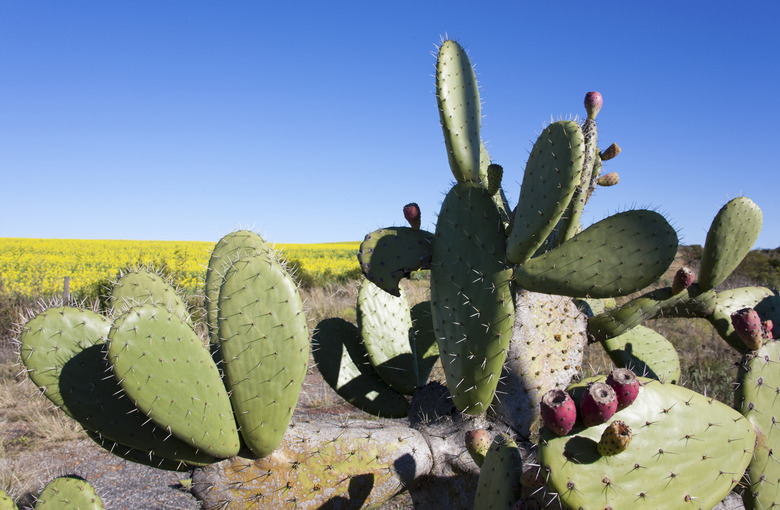What Eats A Cactus?
With their low water needs and resistance to many common pests and diseases, members of the cactus family can be exceptionally resilient. But cactuses are not immune to damage, and some insects and animals will eat them. Even people enjoy eating cactuses: prickly pear cactus (Opuntia humifusa) produces egg-shaped fruits with bright red edible pulp.
Lousy Longhorns
Cactus longhorn beetles are shiny black beetles about 1 inch long that have wide antennae distinctively marked with white bands. The beetles feed on a range of cactus species, damaging either the margins of cactus pads or the terminal flower buds. The University of Arizona Cooperative Extension recommends hand-picking the beetles when they are most active, early in the morning or in late evening, ideally after a warm summer rain. Because hand-picking is effective and beetle populations are usually low, there's no need to use chemical insecticides.
- With their low water needs and resistance to many common pests and diseases, members of the cactus family can be exceptionally resilient.
- But cactuses are not immune to damage, and some insects and animals will eat them.
Bugs That Bug
Common garden pests, such as aphids, spider mites, mealybugs and scale insects can also feed on cactuses. Check cactus plants carefully for crawling insects or cottony, white masses, which may be mealybugs or scale. Fine webs and stippling on cactus skin indicate spider mites. Small groups of pests may be rinsed off with a direct stream of water from the hose or a spray bottle, or by spraying the cactus with horticultural oil. Mix 2 1/2 to 5 tablespoons of horticultural oil with 1 gallon of water, and pour it into a pressurized spray bottle. Check the label's rates because brands vary. Shake well to mix, and coat the cactus evenly. Wear long pants, a long-sleeved shirt and chemical-resistant gloves to avoid getting the oil on your skin. Heavily infested cactuses may need to be thrown out.
- Common garden pests, such as aphids, spider mites, mealybugs and scale insects can also feed on cactuses.
- Check cactus plants carefully for crawling insects or cottony, white masses, which may be mealybugs or scale.
Animal Attacks
During long periods of drought, some animals may resort to feeding on cactuses. Potential culprits include mice, rabbits, ground squirrels and pack rats. Cactuses can often recover if damage is slight. If animals consistently cause damage, consider putting up a fence. Stakes fitted with chicken wire that are at least 2 feet tall will keep out rabbits. Bury the fencing at least 6 inches into the ground to prevent burrowing.
Treat Them Right
Providing the proper cultural care for your cactuses will make then less susceptible to insect attacks, because stressed plants are more likely to attract pests. Good care also helps the cactuses recover faster from any feeding damage. Cactuses generally prefer bright, sunny areas with daytime temperatures during the growing season that stay between 65 and 85 degrees Fahrenheit. Plant in well-draining soil and water sparingly. Only plant cactuses outdoors if they're suitable for your climate. Prickly pears, for example, can grow outdoors in U.S. Department of Agriculture plant hardiness zones 5 through 10.
- During long periods of drought, some animals may resort to feeding on cactuses.
References
- University of California Statewide Integrated Pest Management Program: Rabbits
- Arizona Cooperative Extension: Problems and Pests of Agave, Aloe, Cactus and Yucca
- Clemson Cooperative Extension: Cactus
- Floridata: Opuntia Humifusa
- University of California Statewide Integrated Pest Management Program: Mealy Bugs
- University of California Statewide Integrated Pest Management Program: Scale
